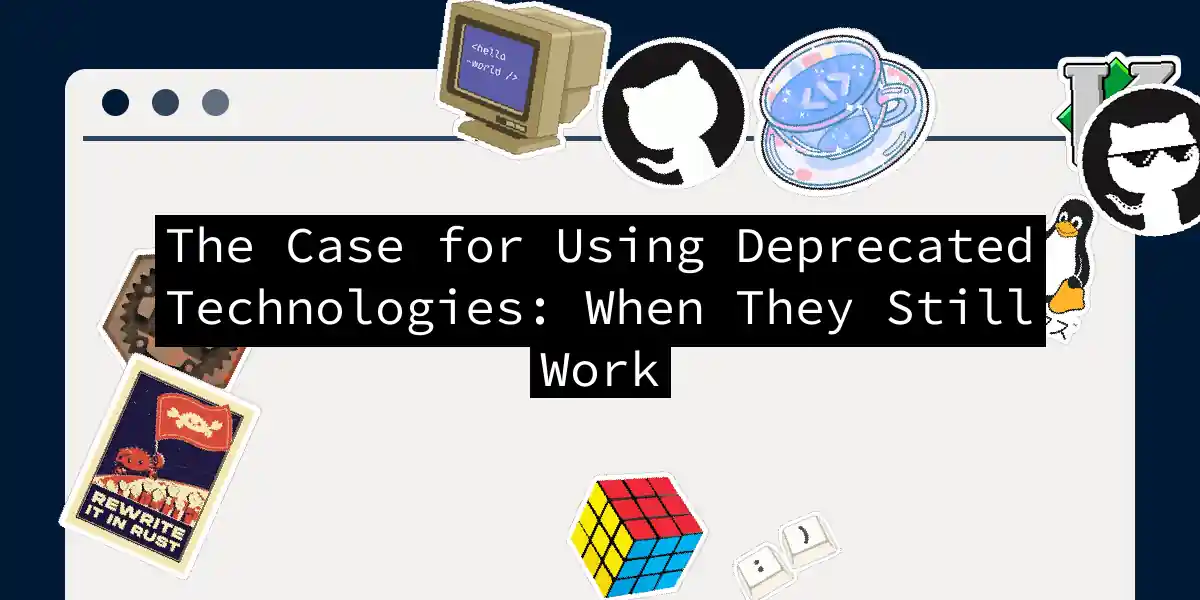The Eternal Dilemma: To Deprecate or Not to Deprecate
In the ever-evolving landscape of software development, the term “deprecated” often carries a negative connotation. It’s like the software equivalent of a warning label on a product: “Caution: This might still work, but use at your own risk.” However, there are scenarios where using deprecated technologies is not only justified but also prudent. Let’s delve into the complexities and nuances of this decision.
Understanding Deprecated Code
Before we dive into the case for using deprecated technologies, it’s essential to understand what deprecated code is. Deprecated code refers to parts of a software system that are no longer recommended for use, often because they have been superseded by newer, better alternatives. However, this does not mean the code is immediately broken or non-functional[1].
The Cost of Change
One of the primary reasons to consider using deprecated technologies is the cost of change. Replacing legacy systems or code can be a monumental task, especially if the existing system has been in operation for years. The financial, temporal, and human resources required to migrate to new technologies can be staggering. For instance, a legacy application that has been working flawlessly for 20 years might require significant investment to update, including costs for change management, training, and bug fixes[2].
The Risk of Disruption
Changing a well-oiled machine can introduce unforeseen risks. New systems, no matter how advanced, come with their own set of bugs and learning curves. The process of transitioning can disrupt business operations, leading to downtime and potential losses. This is particularly critical in industries where continuity is paramount, such as healthcare or finance.
When Deprecated Technologies Still Make Sense
1. Stability and Reliability
Sometimes, the old adage “if it ain’t broke, don’t fix it” holds true. If a deprecated technology is still stable and reliable, there might be little incentive to change it. For example, a legacy database system that has been running without issues for years might not need an immediate overhaul, especially if the new alternatives do not offer significant enough improvements to justify the disruption.
2. Resource Constraints
In many organizations, resources are limited. Developers might be stretched thin between maintaining existing systems and developing new features. In such scenarios, using deprecated technologies can be a pragmatic decision to ensure that the existing system continues to function while resources are allocated to more critical tasks.
3. Compatibility and Interoperability
Legacy systems often have to interact with other older systems or hardware. Replacing these systems with newer technologies can lead to compatibility issues, which might be more challenging to resolve than the benefits gained from the upgrade. For instance, an old application might rely on deprecated APIs that are no longer supported in newer versions, making integration a significant hurdle[3].
Strategies for Managing Deprecated Code
While using deprecated technologies might be necessary, it’s crucial to manage them effectively to minimize risks and ensure they do not become a liability.
Automated Tools
Leveraging automated tools can significantly streamline the process of managing deprecated code. These tools can provide advanced code search, impact analysis, and application portfolio management capabilities. They can generate detailed reports and code visualizations, helping developers understand the dependencies and interactions of deprecated code, making it easier to plan and execute code refactoring efforts when necessary[1].
Testing and Validation
One of the most effective strategies for working with legacy code is to implement robust testing. Adding unit tests and integration tests can help ensure that the code remains maintainable and that any changes do not introduce new bugs. This approach, often referred to as “retroactive TDD,” can transform legacy code into a more malleable state[2].
Example: Managing a Legacy Database System
Let’s consider a scenario where a company is using a legacy database system that is still reliable but has been deprecated.
In this example, the developer evaluates whether the new database system offers enough benefits to justify the migration. If not, they continue using the legacy system while monitoring and maintaining it to ensure it remains stable.
Future Trends and Considerations
As technology continues to evolve, several trends will impact how we manage deprecated code:
AI and Machine Learning
The integration of AI and machine learning will enhance the detection and analysis of deprecated code. These technologies can learn from historical data, identify patterns indicating obsolescence, and even suggest modern alternatives or refactor code autonomously[1].
Enhanced Code Analysis Tools
Future code analysis tools will provide deeper insights into the impact of deprecated code, offering real-time analysis and visualization of code dependencies. This will make it easier for developers to understand the ramifications of removing or updating deprecated segments[1].
Increased Automation and Continuous Monitoring
Cloud-based development environments and collaboration tools will enable real-time collaboration among distributed teams, making it easier to identify and address deprecated code collectively. These platforms will provide centralized repositories for code analysis and refactoring tools, ensuring all team members have access to the latest resources and information[1].
Conclusion
Using deprecated technologies is not always a bad idea, especially when weighed against the costs and risks of change. By understanding the nuances of deprecated code, leveraging automated tools, and implementing robust testing strategies, developers can make informed decisions about when to hold on to legacy systems and when to let go.
In the end, it’s about finding a balance between innovation and pragmatism. Sometimes, the best approach is to let sleeping dogs lie, or in this case, let the reliable legacy code continue to run smoothly while you focus on more pressing challenges. After all, in software development, it’s not just about being cutting-edge; it’s about being effective and efficient.
